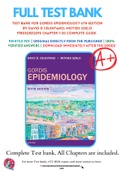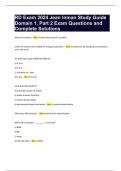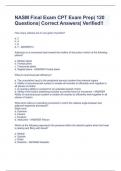Examen
Test Bank For Gordis Epidemiology 6th Edition By David D Celentano; Moyses Szklo 9780323552295 Chapter 1-20 Complete Guide .
Grado
Gordis Epidemiology 6th Edition
Institución
Gordis Epidemiology 6th Edition
Test Bank For Gordis Epidemiology 6th Edition By David D Celentano; Moyses Szklo 2295, 3 , 2318, 5
1 Introduction
2 The Dynamics of Disease Transmission
3 The Occurrence of Disease
4 The Occurrence of Disease
5 Assessing the Validity and Reliability of Diagnostic and Screening Tests
...
[Mostrar más]
Vista previa 4 fuera de 168 páginas
Subido en
17 de diciembre de 2022
Número de páginas
168
Escrito en
2022/2023
Tipo
Examen
Contiene
Preguntas y respuestas
Título del libro: Gordis Epidemiology
Autor(es): David D. Celentano, Moyses Szklo
Edición: 2018 ISBN: 9780323552295 Edición: Desconocido
Examen
Test Bank for Gordis Epidemiology 6th Edition by David D Celentano 9780323552295 (Complete 20 Chapters)
Examen
Test Bank for Gordis Epidemiology, 6th Edition by Celentano, 9780323552295, Covering Chapters 1-20 | Includes Rationales
Examen
Test Bank for Gordis Epidemiology 6th Edition by David D Celentano
Todos para este libro de texto (51)
Institución
Gordis Epidemiology 6th Edition
Grado
Gordis Epidemiology 6th Edition
$20.48
100% de satisfacción garantizada
Inmediatamente disponible después del pago
Tanto en línea como en PDF
No estas atado a nada
PRINTED PDF | ORIGINAL DIRECTLY FROM THE PUBLISHER | 100%







